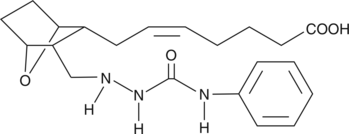Chemicals
Showing 36301–36450 of 41137 results
-
Spinosyn A 17-pseudoaglycone is a pseudoaglycone form of the macrocyclic lactone insecticide spinosyn A (Item No. 16528).{43158} Unlike spinosyn A, spinosyn A 17-pseudoaglycone is not lethal to tobacco budworm (H. virescens) neonate larvae (LC50 = >64 ppm).
Brand:CaymanSKU:25530 - 1 mgAvailable on backorder
Spinosyn A 17-pseudoaglycone is a pseudoaglycone form of the macrocyclic lactone insecticide spinosyn A (Item No. 16528).{43158} Unlike spinosyn A, spinosyn A 17-pseudoaglycone is not lethal to tobacco budworm (H. virescens) neonate larvae (LC50 = >64 ppm).
Brand:CaymanSKU:25530 - 5 mgAvailable on backorder
Spinosyn A aglycone is an aglycone form of the insecticide spinosyn A.{45038} It is formed by acid hydrolysis of spinosyn A 17-pseudoaglycone (Item No. 25530). Spinosyn A aglycone has no insecticidal activity at concentrations up to 64 ppm.
Brand:CaymanSKU:27992 - 1 mgAvailable on backorder
Spinosyn A aglycone is an aglycone form of the insecticide spinosyn A.{45038} It is formed by acid hydrolysis of spinosyn A 17-pseudoaglycone (Item No. 25530). Spinosyn A aglycone has no insecticidal activity at concentrations up to 64 ppm.
Brand:CaymanSKU:27992 - 5 mgAvailable on backorder
Spinosyn D is a spinosoid that is a minor component of spinosad, an insecticide based on chemical compounds found in a bacterial species isolated from sugarcane, S. spinosa.{26993} It acts as an agonist of insect nicotinic acetylcholinesterase receptors.{26993} Spinosyn D demonstrates insecticidal activity against H. virescens larvae (tobacco budworm) with an LD50 value of 0.8 ppm.{26992}
Brand:CaymanSKU:-Available on backorder
Spinosyn D is a spinosoid that is a minor component of spinosad, an insecticide based on chemical compounds found in a bacterial species isolated from sugarcane, S. spinosa.{26993} It acts as an agonist of insect nicotinic acetylcholinesterase receptors.{26993} Spinosyn D demonstrates insecticidal activity against H. virescens larvae (tobacco budworm) with an LD50 value of 0.8 ppm.{26992}
Brand:CaymanSKU:-Available on backorder
Spinosyn D 17-pseudoaglycone is a hydrolysis product of the minor insecticide component spinosyn D (Item No. 19158).{45038} Unlike spinosyn D, spinosyn D 17-pseudoaglycone is not lethal to tobacco budworms (H. virescens) when used at concentrations up to 64 ppm.
Brand:CaymanSKU:27975 - 2.5 mgAvailable on backorder
Spinosyn D 17-pseudoaglycone is a hydrolysis product of the minor insecticide component spinosyn D (Item No. 19158).{45038} Unlike spinosyn D, spinosyn D 17-pseudoaglycone is not lethal to tobacco budworms (H. virescens) when used at concentrations up to 64 ppm.
Brand:CaymanSKU:27975 - 500 µgAvailable on backorder
Spinosyn D aglycone is an aglycone form of the insecticide spinosyn D (Item No. 19158).{42776} Unlike spinosyn D, spinosyn D aglycone is not lethal to H. virescens (tobacco budworm) neonate larvae (LC50 = >64 ppm).
Brand:CaymanSKU:27937 - 2.5 mgAvailable on backorder
Spinosyn D aglycone is an aglycone form of the insecticide spinosyn D (Item No. 19158).{42776} Unlike spinosyn D, spinosyn D aglycone is not lethal to H. virescens (tobacco budworm) neonate larvae (LC50 = >64 ppm).
Brand:CaymanSKU:27937 - 500 µgAvailable on backorder
Spiramycin is a 16-membered macrolide antibiotic with anti-parasitic actions. Like other macrolides, spiramcyin inhibits microbial protein synthesis.{22680} It is effective against the parasitic protozoan T. gondii in clinical trials.{32005}
Brand:CaymanSKU:20267 -Available on backorder
Spiramycin is a 16-membered macrolide antibiotic with anti-parasitic actions. Like other macrolides, spiramcyin inhibits microbial protein synthesis.{22680} It is effective against the parasitic protozoan T. gondii in clinical trials.{32005}
Brand:CaymanSKU:20267 -Available on backorder
Spiramycin is a 16-membered macrolide antibiotic with anti-parasitic actions. Like other macrolides, spiramcyin inhibits microbial protein synthesis.{22680} It is effective against the parasitic protozoan T. gondii in clinical trials.{32005}
Brand:CaymanSKU:20267 -Available on backorder
Spiro-MeOTAD is a stable and efficient hole-transport material in organic light-emitting devices and in solid-state dye-sensitized solar cells (ssDSSCs).{28348} It yields higher ssDSSC efficiency compared to the liquid electrolyte for DSSC solar cells due to its reasonable charge carrier mobility and its amorphous nature and high solubility, which enables excellent infiltration into mesoporous titania films.{28348} Neutral spiro-MeOTAD absorbs light in the UV region of the spectrum, while its oxidized forms exhibit strong absorptions throughout the visible and near-infrared ranges.{28348}
Brand:CaymanSKU:-Available on backorder
Spiro-MeOTAD is a stable and efficient hole-transport material in organic light-emitting devices and in solid-state dye-sensitized solar cells (ssDSSCs).{28348} It yields higher ssDSSC efficiency compared to the liquid electrolyte for DSSC solar cells due to its reasonable charge carrier mobility and its amorphous nature and high solubility, which enables excellent infiltration into mesoporous titania films.{28348} Neutral spiro-MeOTAD absorbs light in the UV region of the spectrum, while its oxidized forms exhibit strong absorptions throughout the visible and near-infrared ranges.{28348}
Brand:CaymanSKU:-Available on backorder
Spiro-MeOTAD is a stable and efficient hole-transport material in organic light-emitting devices and in solid-state dye-sensitized solar cells (ssDSSCs).{28348} It yields higher ssDSSC efficiency compared to the liquid electrolyte for DSSC solar cells due to its reasonable charge carrier mobility and its amorphous nature and high solubility, which enables excellent infiltration into mesoporous titania films.{28348} Neutral spiro-MeOTAD absorbs light in the UV region of the spectrum, while its oxidized forms exhibit strong absorptions throughout the visible and near-infrared ranges.{28348}
Brand:CaymanSKU:-Available on backorder
Spiro-MeOTAD is a stable and efficient hole-transport material in organic light-emitting devices and in solid-state dye-sensitized solar cells (ssDSSCs).{28348} It yields higher ssDSSC efficiency compared to the liquid electrolyte for DSSC solar cells due to its reasonable charge carrier mobility and its amorphous nature and high solubility, which enables excellent infiltration into mesoporous titania films.{28348} Neutral spiro-MeOTAD absorbs light in the UV region of the spectrum, while its oxidized forms exhibit strong absorptions throughout the visible and near-infrared ranges.{28348}
Brand:CaymanSKU:-Available on backorder
Spiro-oxanthromicin A is a polyketide that has been found in Streptomyces.{38316} It induces mislocalization of K-RAS in MDCK cells (IC50 = 26.7 µM).
Brand:CaymanSKU:32555 - 100 µgAvailable on backorder
Spiro-oxanthromicin A is a polyketide that has been found in Streptomyces.{38316} It induces mislocalization of K-RAS in MDCK cells (IC50 = 26.7 µM).
Brand:CaymanSKU:32555 - 500 µgAvailable on backorder
Spirohexenolide A is a metabolite originally isolated from S. platensis.{42121} It inhibits growth in the NCI-60 cancer cell line panel (GI50s = 0.1-17 μM) with the RPMI-8226 multiple myeloma, HOP-92 lung, and SW620 colon cancer cell lines being most sensitive (GI50s = 254, 191, and 565 nM, respectively). Spirohexenolide A also binds to human macrophage migration inhibition factor (MIF; Kd = 35.9 μM) and inhibits MIF cellular uptake and lysosomal localization in HCT116 cells.{42122}
Brand:CaymanSKU:25116 - 100 µgAvailable on backorder
Spirohexenolide A is a metabolite originally isolated from S. platensis.{42121} It inhibits growth in the NCI-60 cancer cell line panel (GI50s = 0.1-17 μM) with the RPMI-8226 multiple myeloma, HOP-92 lung, and SW620 colon cancer cell lines being most sensitive (GI50s = 254, 191, and 565 nM, respectively). Spirohexenolide A also binds to human macrophage migration inhibition factor (MIF; Kd = 35.9 μM) and inhibits MIF cellular uptake and lysosomal localization in HCT116 cells.{42122}
Brand:CaymanSKU:25116 - 500 µgAvailable on backorder
Spirolaxine is a long-chain phthalide produced by the fungus S. laxum that has antibacterial properties.{34604,34610} Spirolaxine is a potent anti-H. pylori agent (MIC = 0.2 µg/cm3) with weak activity against E. coli.{34610,34608} Spirolaxine (1-40 µM) inhibits proliferation of endothelial (BMEC, HUVEC) and tumor (LoVo, HL-60) cells in culture.{34607} B. megaterium and C. echinulate produce hydroxylated metabolites of spirolaxine when given spirolaxine as a substrate.{34605}
Brand:CaymanSKU:22063 -Out of stock
Spirolaxine is a long-chain phthalide produced by the fungus S. laxum that has antibacterial properties.{34604,34610} Spirolaxine is a potent anti-H. pylori agent (MIC = 0.2 µg/cm3) with weak activity against E. coli.{34610,34608} Spirolaxine (1-40 µM) inhibits proliferation of endothelial (BMEC, HUVEC) and tumor (LoVo, HL-60) cells in culture.{34607} B. megaterium and C. echinulate produce hydroxylated metabolites of spirolaxine when given spirolaxine as a substrate.{34605}
Brand:CaymanSKU:22063 -Out of stock
Spiromesifen is an insecticide and acaricide that reduces lipid biosynthesis via inhibition of acetyl-CoA carboxylase.{43346,43347} It inhibits chitinase from Egyptian cotton leafworm (S. littoralis) larvae (IC50s = 0.60 and 0.72 μM for enzyme isolated from lab and field strains, respectively).{43348} It induces toxicity in whitefly (T. vaporariorum) nymphs (LC50 = 0.61 mg/L), spider mite (T. cinnabarinus) eggs (LC50 = 0.16 mg/kg), and second instar larvae of S. littoralis lab and field strains (LC50s = 0.44 and 0.68 ppm, respectively, at 72 hours post-application).{43346,43347,43348} Spiromesifen (600 mg/kg) also induces 50, 60, and 70% mortality in the Lepidoptera pests H. armigera, O. nubilalis, and P. xylostella, respectively, and induces 100% mortality in M. separata when used at a dose of 100 mg/kg.{43347} It induces toxicity in D. magna (EC50 = >0.092 mg a.s./L) and the fish species O. mykiss and L. macrochirus (LC50s = 0.016 and >0.034 mg a.s./L, respectively) but not rats (LD50 = >2,000 mg/kg).{43350} Spiromesifen also inhibits the human GST isozyme GSTA1-1 (IC50 = 12.1 μM).{43349}
Brand:CaymanSKU:25822 - 100 mgAvailable on backorder
Spiromesifen is an insecticide and acaricide that reduces lipid biosynthesis via inhibition of acetyl-CoA carboxylase.{43346,43347} It inhibits chitinase from Egyptian cotton leafworm (S. littoralis) larvae (IC50s = 0.60 and 0.72 μM for enzyme isolated from lab and field strains, respectively).{43348} It induces toxicity in whitefly (T. vaporariorum) nymphs (LC50 = 0.61 mg/L), spider mite (T. cinnabarinus) eggs (LC50 = 0.16 mg/kg), and second instar larvae of S. littoralis lab and field strains (LC50s = 0.44 and 0.68 ppm, respectively, at 72 hours post-application).{43346,43347,43348} Spiromesifen (600 mg/kg) also induces 50, 60, and 70% mortality in the Lepidoptera pests H. armigera, O. nubilalis, and P. xylostella, respectively, and induces 100% mortality in M. separata when used at a dose of 100 mg/kg.{43347} It induces toxicity in D. magna (EC50 = >0.092 mg a.s./L) and the fish species O. mykiss and L. macrochirus (LC50s = 0.016 and >0.034 mg a.s./L, respectively) but not rats (LD50 = >2,000 mg/kg).{43350} Spiromesifen also inhibits the human GST isozyme GSTA1-1 (IC50 = 12.1 μM).{43349}
Brand:CaymanSKU:25822 - 50 mgAvailable on backorder
Spironolactone (Item No. 9000324) is an analytical reference standard categorized as a steroid.{11234,33132} It is a diuretic that has been abused as a performance-enhancing drug and masking agent in sports doping.{33139} This product is intended for research and forensic applications
Brand:CaymanSKU:9000324 - 1 mgAvailable on backorder
Spironolactone (Item No. 9000324) is an analytical reference standard categorized as a steroid.{11234,33132} It is a diuretic that has been abused as a performance-enhancing drug and masking agent in sports doping.{33139} This product is intended for research and forensic applications
Brand:CaymanSKU:9000324 - 5 mgAvailable on backorder
Spirotetramat is an insecticide.{42381} It is active against C. pyri nymphs in vitro (LC50 = 6.51-12.53 mg AI/L) and induces mortality of C. pyri nymphs in European pear (P. communis) fields by 99.2% 15 days after application at a concentration of 27 g/hectare. Spirotetramat also reduces O. insidiosus embryonic viability and nymph survival.{42382} It exhibits aquatic toxicity, increasing expression of glutathione peroxidase (Gpx) and superoxide dismutase (SOD), decreasing production of malondialdehyde (MDA), and inducing lethality in Chinese toad (B. gargarizans) tadpoles (LC50 = 6.98 mg/L).{42383}
Brand:CaymanSKU:25634 - 100 mgAvailable on backorder
Spirotetramat is an insecticide.{42381} It is active against C. pyri nymphs in vitro (LC50 = 6.51-12.53 mg AI/L) and induces mortality of C. pyri nymphs in European pear (P. communis) fields by 99.2% 15 days after application at a concentration of 27 g/hectare. Spirotetramat also reduces O. insidiosus embryonic viability and nymph survival.{42382} It exhibits aquatic toxicity, increasing expression of glutathione peroxidase (Gpx) and superoxide dismutase (SOD), decreasing production of malondialdehyde (MDA), and inducing lethality in Chinese toad (B. gargarizans) tadpoles (LC50 = 6.98 mg/L).{42383}
Brand:CaymanSKU:25634 - 25 mgAvailable on backorder
Spirotetramat is an insecticide.{42381} It is active against C. pyri nymphs in vitro (LC50 = 6.51-12.53 mg AI/L) and induces mortality of C. pyri nymphs in European pear (P. communis) fields by 99.2% 15 days after application at a concentration of 27 g/hectare. Spirotetramat also reduces O. insidiosus embryonic viability and nymph survival.{42382} It exhibits aquatic toxicity, increasing expression of glutathione peroxidase (Gpx) and superoxide dismutase (SOD), decreasing production of malondialdehyde (MDA), and inducing lethality in Chinese toad (B. gargarizans) tadpoles (LC50 = 6.98 mg/L).{42383}
Brand:CaymanSKU:25634 - 50 mgAvailable on backorder
Spiroxamine is a tertiary amine fungicide and an inhibitor of Δ14 reductase/Δ8→Δ7 isomerase.{36876} It inhibits the growth of N. parvum, B. dothidea, D. seriata, and L. theobromae isolates from grape vines (EC50s = 0.97-10.28 mg/L).{36877} Spiroxamine (0.03-30 μM) reduces network formation in rat cortical cultures.{36878} It is also cytotoxic to MDA-kb2 cells (EC20 = 9.29 μM).{42005}
Brand:CaymanSKU:25823 - 100 mgAvailable on backorder
Spiroxamine is a tertiary amine fungicide and an inhibitor of Δ14 reductase/Δ8→Δ7 isomerase.{36876} It inhibits the growth of N. parvum, B. dothidea, D. seriata, and L. theobromae isolates from grape vines (EC50s = 0.97-10.28 mg/L).{36877} Spiroxamine (0.03-30 μM) reduces network formation in rat cortical cultures.{36878} It is also cytotoxic to MDA-kb2 cells (EC20 = 9.29 μM).{42005}
Brand:CaymanSKU:25823 - 50 mgAvailable on backorder
Active enzyme isolated from bee venom · One unit of enzyme hydrolyzes one µmol of Diheptanoyl Thio-PC per minute at 25°C.
Brand:CaymanSKU:60500 - 1 mgAvailable on backorder
Active enzyme isolated from bee venom · One unit of enzyme hydrolyzes one µmol of Diheptanoyl Thio-PC per minute at 25°C.
Brand:CaymanSKU:60500 - 10 mgAvailable on backorder
Active enzyme isolated from bee venom · One unit of enzyme hydrolyzes one µmol of Diheptanoyl Thio-PC per minute at 25°C.
Brand:CaymanSKU:60500 - 25 mgAvailable on backorder
Active enzyme isolated from bee venom · One unit of enzyme hydrolyzes one µmol of Diheptanoyl Thio-PC per minute at 25°C.
Brand:CaymanSKU:60500 - 5 mgAvailable on backorder
Secreted phospholipases A2 (sPLA2s) are a diverse family of low molecular weight PLA2s with tissue-specific expression patterns and actions.{23479} The group IIA sPLA2 (sPLA2-IIA) was originally purified from platelets and exudates from patients with rheumatoid arthritis.{23479} Its expression can be induced by inflammatory mediators, and mouse studies suggest that it may play roles in colorectal polyposis, atherosclerosis, and bacterial infections.{23479,23478} sPLA2 inhibitor is an orally active inhibitor of sPLA2-IIA.{28309} It protects against intestinal reperfusion injury in rats when given at 10 mg/kg orally.{28309} sPLA2 inhibitor also attenuates NF-κB signaling in lung cancer cells and protects against diet-induced metabolic syndrome in rats.{28310,28308}
Brand:CaymanSKU:-Available on backorder
Secreted phospholipases A2 (sPLA2s) are a diverse family of low molecular weight PLA2s with tissue-specific expression patterns and actions.{23479} The group IIA sPLA2 (sPLA2-IIA) was originally purified from platelets and exudates from patients with rheumatoid arthritis.{23479} Its expression can be induced by inflammatory mediators, and mouse studies suggest that it may play roles in colorectal polyposis, atherosclerosis, and bacterial infections.{23479,23478} sPLA2 inhibitor is an orally active inhibitor of sPLA2-IIA.{28309} It protects against intestinal reperfusion injury in rats when given at 10 mg/kg orally.{28309} sPLA2 inhibitor also attenuates NF-κB signaling in lung cancer cells and protects against diet-induced metabolic syndrome in rats.{28310,28308}
Brand:CaymanSKU:-Available on backorder
Secreted phospholipases A2 (sPLA2s) are a diverse family of low molecular weight PLA2s with tissue-specific expression patterns and actions.{23479} The group IIA sPLA2 (sPLA2-IIA) was originally purified from platelets and exudates from patients with rheumatoid arthritis.{23479} Its expression can be induced by inflammatory mediators, and mouse studies suggest that it may play roles in colorectal polyposis, atherosclerosis, and bacterial infections.{23479,23478} sPLA2 inhibitor is an orally active inhibitor of sPLA2-IIA.{28309} It protects against intestinal reperfusion injury in rats when given at 10 mg/kg orally.{28309} sPLA2 inhibitor also attenuates NF-κB signaling in lung cancer cells and protects against diet-induced metabolic syndrome in rats.{28310,28308}
Brand:CaymanSKU:-Available on backorder
Secreted phospholipases A2 (sPLA2s) are a diverse family of low molecular weight PLA2s with tissue-specific expression patterns and actions.{23479} The group IIA sPLA2 (sPLA2-IIA) was originally purified from platelets and exudates from patients with rheumatoid arthritis.{23479} Its expression can be induced by inflammatory mediators, and mouse studies suggest that it may play roles in colorectal polyposis, atherosclerosis, and bacterial infections.{23479,23478} sPLA2 inhibitor is an orally active inhibitor of sPLA2-IIA.{28309} It protects against intestinal reperfusion injury in rats when given at 10 mg/kg orally.{28309} sPLA2 inhibitor also attenuates NF-κB signaling in lung cancer cells and protects against diet-induced metabolic syndrome in rats.{28310,28308}
Brand:CaymanSKU:-Available on backorder
Sporidesmolide is a depsipeptide originally isolated from S. bakeri that has no activity against a variety of bacteria and fungi.{35217,35218}
Brand:CaymanSKU:23882 - 2.5 mgAvailable on backorder
Sporidesmolide is a depsipeptide originally isolated from S. bakeri that has no activity against a variety of bacteria and fungi.{35217,35218}
Brand:CaymanSKU:23882 - 500 µgAvailable on backorder
Brand:CaymanSKU:28133 - 2.5 mgAvailable on backorder
Brand:CaymanSKU:28133 - 500 µgAvailable on backorder
Brand:CaymanSKU:26593 - 2.5 mgAvailable on backorder
Brand:CaymanSKU:26593 - 500 µgAvailable on backorder
Sporidesmolide V is a cyclodepsipeptide fungal metabolite originally isolated from P. chartarum.{39832}
Brand:CaymanSKU:25531 - 2.5 mgAvailable on backorder
Sporidesmolide V is a cyclodepsipeptide fungal metabolite originally isolated from P. chartarum.{39832}
Brand:CaymanSKU:25531 - 500 µgAvailable on backorder
Sporogen-AO 1 is a fungal metabolite originally isolated from A. oryzae that has diverse biological activities.{53570,53571,53572,53573,53574} It inhibits HIV-1 Tat transactivation in a cell-based assay with an IC50 value of 15.8 µM.{53573} Sporogen-AO 1 is cytotoxic to HeLa, KB, and NCI H187 cancer cells (IC50s = 8.3, 9, and 5.1 µM, respectively).{53571,53574} It is active against C. albicans (MIC = 4 mM).{53572}
Brand:CaymanSKU:29576 - 1 mgAvailable on backorder
Sporothriolide is a fungal metabolite that has been found in Sporothrix.{52434} It is active against the plant pathogenic fungi U. violacea, M. microspore, and E. repens, and the alga C. fusca, but not the bacteria B. megaterium and E. coli, when used at a concentration of 10 mg/ml. Sporothriolide inhibits mycelial growth of the plant pathogenic fungus R. solani (EC50 = 3.04 µg/ml) and protects against R. solani-induced rice sheath blight on rice plants when used at a concentration of 200 µg/ml.{52435} It also prevents necrosis induced by the plant pathogenic fungus B. cinerea in pepper seedlings at 500 ppm.{52434} Sporothriolide (4 mg/ml) prevents germination of L. sativum and M. sativa seedlings.
Brand:CaymanSKU:29323 - 1 mgAvailable on backorder
SPQ is a fluorescent chloride indicator.{43896} Its fluorescence is rapidly quenched by chloride in vitro. It has been used to assess voltage-sensitive chloride transport in placental microvillus vesicles. It has also been used to continuously quantify intracellular calcium efflux induced by parathyroid hormone, forskolin (Item No. 11018), and phorbol 12-myristate 13-acetate (PMA; Item No. 10008014) in isolated human erythrocytes.{43897} In addition, SPQ has been used to determine the type of ion conductance induced by the cystic fibrosis transmembrane conductance regulator (CFTR) in HEK293 cells expressing pTrial10-CRTR2.{43898} SPQ displays excitation maxima of 320 and 350 nm and an emission maximum of 445 nm.{43896}
Brand:CaymanSKU:27604 - 100 mgAvailable on backorder
SPQ is a fluorescent chloride indicator.{43896} Its fluorescence is rapidly quenched by chloride in vitro. It has been used to assess voltage-sensitive chloride transport in placental microvillus vesicles. It has also been used to continuously quantify intracellular calcium efflux induced by parathyroid hormone, forskolin (Item No. 11018), and phorbol 12-myristate 13-acetate (PMA; Item No. 10008014) in isolated human erythrocytes.{43897} In addition, SPQ has been used to determine the type of ion conductance induced by the cystic fibrosis transmembrane conductance regulator (CFTR) in HEK293 cells expressing pTrial10-CRTR2.{43898} SPQ displays excitation maxima of 320 and 350 nm and an emission maximum of 445 nm.{43896}
Brand:CaymanSKU:27604 - 250 mgAvailable on backorder
SPQ is a fluorescent chloride indicator.{43896} Its fluorescence is rapidly quenched by chloride in vitro. It has been used to assess voltage-sensitive chloride transport in placental microvillus vesicles. It has also been used to continuously quantify intracellular calcium efflux induced by parathyroid hormone, forskolin (Item No. 11018), and phorbol 12-myristate 13-acetate (PMA; Item No. 10008014) in isolated human erythrocytes.{43897} In addition, SPQ has been used to determine the type of ion conductance induced by the cystic fibrosis transmembrane conductance regulator (CFTR) in HEK293 cells expressing pTrial10-CRTR2.{43898} SPQ displays excitation maxima of 320 and 350 nm and an emission maximum of 445 nm.{43896}
Brand:CaymanSKU:27604 - 500 mgAvailable on backorder
SPRi 3 is an inhibitor of sepiapterin reductase (SPR), an enzyme that catalyzes the formation of tetrahydrobiopterin (BH4), with IC50 values of 62 and 14 nM for the recombinant human and rat enzymes, respectively.{57061} It is selective for SPR over GTP cyclohydroxylase 1 (GCH1) in primary mouse dorsal root ganglia sensory neurons at 10 µM.{57062} SPRi 3 (50 µM) inhibits proliferation of anti-CD3 and anti-CD28 antibody-stimulated isolated human peripheral blood mononuclear cells (PBMCs) or CD4+ T cells.{57063} Intraperitoneal administration of SPRi 3 (300 mg/kg) decreases brain BH4 levels and reduces mechanical allodynia in mouse models of peripheral neuropathy induced by spared nerve injury (SNI) or chronic constriction injury (CCI).{57062} It also decreases macrophage infiltration and thermal hyperalgesia in the inflamed joints of a mouse model of rheumatoid arthritis induced by complete Freund’s adjuvant (CFA) at the same dose.
Brand:CaymanSKU:30950 - 1 mgAvailable on backorder
SPRi 3 is an inhibitor of sepiapterin reductase (SPR), an enzyme that catalyzes the formation of tetrahydrobiopterin (BH4), with IC50 values of 62 and 14 nM for the recombinant human and rat enzymes, respectively.{57061} It is selective for SPR over GTP cyclohydroxylase 1 (GCH1) in primary mouse dorsal root ganglia sensory neurons at 10 µM.{57062} SPRi 3 (50 µM) inhibits proliferation of anti-CD3 and anti-CD28 antibody-stimulated isolated human peripheral blood mononuclear cells (PBMCs) or CD4+ T cells.{57063} Intraperitoneal administration of SPRi 3 (300 mg/kg) decreases brain BH4 levels and reduces mechanical allodynia in mouse models of peripheral neuropathy induced by spared nerve injury (SNI) or chronic constriction injury (CCI).{57062} It also decreases macrophage infiltration and thermal hyperalgesia in the inflamed joints of a mouse model of rheumatoid arthritis induced by complete Freund’s adjuvant (CFA) at the same dose.
Brand:CaymanSKU:30950 - 5 mgAvailable on backorder
SQ 22,536 is an inhibitor of adenylyl cyclase with an IC50 value of 13 μM for inhibition of prostaglandin E1-stimulated increase in cAMP in intact platelets.{20863} It has been used to evaluate adenylyl cyclase activity during iloprost-induced vasorelaxation of isolated pulmonary veins or aorta in several research paradigms, inhibiting cAMP elevation at concentrations of 100-300 μM without effecting relaxation.{20861,20862}
Brand:CaymanSKU:-SQ 22,536 is an inhibitor of adenylyl cyclase with an IC50 value of 13 μM for inhibition of prostaglandin E1-stimulated increase in cAMP in intact platelets.{20863} It has been used to evaluate adenylyl cyclase activity during iloprost-induced vasorelaxation of isolated pulmonary veins or aorta in several research paradigms, inhibiting cAMP elevation at concentrations of 100-300 μM without effecting relaxation.{20861,20862}
Brand:CaymanSKU:-SQ 22,536 is an inhibitor of adenylyl cyclase with an IC50 value of 13 μM for inhibition of prostaglandin E1-stimulated increase in cAMP in intact platelets.{20863} It has been used to evaluate adenylyl cyclase activity during iloprost-induced vasorelaxation of isolated pulmonary veins or aorta in several research paradigms, inhibiting cAMP elevation at concentrations of 100-300 μM without effecting relaxation.{20861,20862}
Brand:CaymanSKU:-SQ 22,536 is an inhibitor of adenylyl cyclase with an IC50 value of 13 μM for inhibition of prostaglandin E1-stimulated increase in cAMP in intact platelets.{20863} It has been used to evaluate adenylyl cyclase activity during iloprost-induced vasorelaxation of isolated pulmonary veins or aorta in several research paradigms, inhibiting cAMP elevation at concentrations of 100-300 μM without effecting relaxation.{20861,20862}
Brand:CaymanSKU:-SQ 29,548 is a highly selective TP receptor antagonist which binds to the human recombinant TP receptor with a Ki of 4.1 nM.{8322} It inhibits the aggregation of washed human platelets induced by U-46619 with an IC50 of 0.06 µM.{6643} It antagonizes U-46619 induced contraction of rat and guinea pig tracheal, arterial, and venous smooth muscles with drug/receptor dissociation constants (KB) in the range of 0.5-1.7 nM.{1099} SQ 29,548 also inhibits the contraction of rat vascular smooth muscle induced by 8-iso PGF2α.{955}
Brand:CaymanSKU:-Available on backorder
SQ 29,548 is a highly selective TP receptor antagonist which binds to the human recombinant TP receptor with a Ki of 4.1 nM.{8322} It inhibits the aggregation of washed human platelets induced by U-46619 with an IC50 of 0.06 µM.{6643} It antagonizes U-46619 induced contraction of rat and guinea pig tracheal, arterial, and venous smooth muscles with drug/receptor dissociation constants (KB) in the range of 0.5-1.7 nM.{1099} SQ 29,548 also inhibits the contraction of rat vascular smooth muscle induced by 8-iso PGF2α.{955}
Brand:CaymanSKU:-Available on backorder
SQ 29,548 is a highly selective TP receptor antagonist which binds to the human recombinant TP receptor with a Ki of 4.1 nM.{8322} It inhibits the aggregation of washed human platelets induced by U-46619 with an IC50 of 0.06 µM.{6643} It antagonizes U-46619 induced contraction of rat and guinea pig tracheal, arterial, and venous smooth muscles with drug/receptor dissociation constants (KB) in the range of 0.5-1.7 nM.{1099} SQ 29,548 also inhibits the contraction of rat vascular smooth muscle induced by 8-iso PGF2α.{955}
Brand:CaymanSKU:-Available on backorder
Squalene is a biosynthetic precursor to all steroids and a terpene originally isolated from shark liver oil.{45222,45221} Squalene is produced in mammals by condensation of two farnesyl diphosphate molecules by squalene synthase and then oxidized to squalene epoxide for use in the biosynthesis of lanosterol (Item No. 19521), cholesterol, and other steroids.{45222} An oil-in-water emulsion of squalene synergistically increases adaptive immune responses to glucopyranosyl lipid adjuvant (GLA), a toll-like receptor 4 (TLR4) agonist, compared with an aqueous formulation of GLA.{45223} Formulations containing squalene have been used as adjuvants in vaccines and as hair and skin conditioning agents.
Brand:CaymanSKU:27058 - 100 gAvailable on backorder
Squalene is a biosynthetic precursor to all steroids and a terpene originally isolated from shark liver oil.{45222,45221} Squalene is produced in mammals by condensation of two farnesyl diphosphate molecules by squalene synthase and then oxidized to squalene epoxide for use in the biosynthesis of lanosterol (Item No. 19521), cholesterol, and other steroids.{45222} An oil-in-water emulsion of squalene synergistically increases adaptive immune responses to glucopyranosyl lipid adjuvant (GLA), a toll-like receptor 4 (TLR4) agonist, compared with an aqueous formulation of GLA.{45223} Formulations containing squalene have been used as adjuvants in vaccines and as hair and skin conditioning agents.
Brand:CaymanSKU:27058 - 50 gAvailable on backorder
SR 0987 is an agonist of the T cell-specific isoform of RORγ (RORγt, retinoic acid receptor-related orphan receptor-γt), inducing reporter gene expression with an EC50 value of ~800 nM.{31062} Stimulation of mouse EL4 T lymphocytes with SR 0987, following activation with PMA (Item No. 10008014) and ionomycin (Item No. 10004974), increases expression of the RORγt target IL-17, while expression of the programmed cell death protein PD-1 is decreased and granzyme B is unchanged.{31062} Decreased cell surface PD-1 protein, assessed by flow cytometry, is observed in a variety of T cells treated with SR 0987.{31062}
Brand:CaymanSKU:-Available on backorder
SR 0987 is an agonist of the T cell-specific isoform of RORγ (RORγt, retinoic acid receptor-related orphan receptor-γt), inducing reporter gene expression with an EC50 value of ~800 nM.{31062} Stimulation of mouse EL4 T lymphocytes with SR 0987, following activation with PMA (Item No. 10008014) and ionomycin (Item No. 10004974), increases expression of the RORγt target IL-17, while expression of the programmed cell death protein PD-1 is decreased and granzyme B is unchanged.{31062} Decreased cell surface PD-1 protein, assessed by flow cytometry, is observed in a variety of T cells treated with SR 0987.{31062}
Brand:CaymanSKU:-Available on backorder
SR 0987 is an agonist of the T cell-specific isoform of RORγ (RORγt, retinoic acid receptor-related orphan receptor-γt), inducing reporter gene expression with an EC50 value of ~800 nM.{31062} Stimulation of mouse EL4 T lymphocytes with SR 0987, following activation with PMA (Item No. 10008014) and ionomycin (Item No. 10004974), increases expression of the RORγt target IL-17, while expression of the programmed cell death protein PD-1 is decreased and granzyme B is unchanged.{31062} Decreased cell surface PD-1 protein, assessed by flow cytometry, is observed in a variety of T cells treated with SR 0987.{31062}
Brand:CaymanSKU:-Available on backorder
SR 0987 is an agonist of the T cell-specific isoform of RORγ (RORγt, retinoic acid receptor-related orphan receptor-γt), inducing reporter gene expression with an EC50 value of ~800 nM.{31062} Stimulation of mouse EL4 T lymphocytes with SR 0987, following activation with PMA (Item No. 10008014) and ionomycin (Item No. 10004974), increases expression of the RORγt target IL-17, while expression of the programmed cell death protein PD-1 is decreased and granzyme B is unchanged.{31062} Decreased cell surface PD-1 protein, assessed by flow cytometry, is observed in a variety of T cells treated with SR 0987.{31062}
Brand:CaymanSKU:-Available on backorder
Retinoic-acid-receptor-related orphan receptors (ROR) α and γ play a key role in the development of T-helper cells that produce interleukin-17 (TH17 cells), a subset of CD4+ T-cells that contribute to the inflammatory process and have been implicated in the pathology of autoimmune diseases. SR 1001 is a synthetic ligand specific for RORα and RORγ (Kis = 172 and 111 nM, respectively) that functions as an inverse agonist at these receptors.{19493} SR 1001 has been shown to suppress IL-17 promoter driven transcriptional activity by inhibiting the interaction of co-activators such as TRAP220 nuclear receptor box 2 peptide (IC50 = 117 nM) and SRC2 with RORα and RORγ as well as by increasing the recruitment of corepressors such as NCoR. At 5 μM, SR 1001 inhibits TH17 cell differentiation and IL-17A secretion in cultured splenocytes and human PBMCs. A 25 mg/kg dose of SR 1001 twice/day delays the onset and the severity of experimental autoimmune encephalomyelitis, a mouse model of multiple sclerosis.{19493}
Brand:CaymanSKU:10922 - 1 mgAvailable on backorder
Retinoic-acid-receptor-related orphan receptors (ROR) α and γ play a key role in the development of T-helper cells that produce interleukin-17 (TH17 cells), a subset of CD4+ T-cells that contribute to the inflammatory process and have been implicated in the pathology of autoimmune diseases. SR 1001 is a synthetic ligand specific for RORα and RORγ (Kis = 172 and 111 nM, respectively) that functions as an inverse agonist at these receptors.{19493} SR 1001 has been shown to suppress IL-17 promoter driven transcriptional activity by inhibiting the interaction of co-activators such as TRAP220 nuclear receptor box 2 peptide (IC50 = 117 nM) and SRC2 with RORα and RORγ as well as by increasing the recruitment of corepressors such as NCoR. At 5 μM, SR 1001 inhibits TH17 cell differentiation and IL-17A secretion in cultured splenocytes and human PBMCs. A 25 mg/kg dose of SR 1001 twice/day delays the onset and the severity of experimental autoimmune encephalomyelitis, a mouse model of multiple sclerosis.{19493}
Brand:CaymanSKU:10922 - 10 mgAvailable on backorder
Retinoic-acid-receptor-related orphan receptors (ROR) α and γ play a key role in the development of T-helper cells that produce interleukin-17 (TH17 cells), a subset of CD4+ T-cells that contribute to the inflammatory process and have been implicated in the pathology of autoimmune diseases. SR 1001 is a synthetic ligand specific for RORα and RORγ (Kis = 172 and 111 nM, respectively) that functions as an inverse agonist at these receptors.{19493} SR 1001 has been shown to suppress IL-17 promoter driven transcriptional activity by inhibiting the interaction of co-activators such as TRAP220 nuclear receptor box 2 peptide (IC50 = 117 nM) and SRC2 with RORα and RORγ as well as by increasing the recruitment of corepressors such as NCoR. At 5 μM, SR 1001 inhibits TH17 cell differentiation and IL-17A secretion in cultured splenocytes and human PBMCs. A 25 mg/kg dose of SR 1001 twice/day delays the onset and the severity of experimental autoimmune encephalomyelitis, a mouse model of multiple sclerosis.{19493}
Brand:CaymanSKU:10922 - 25 mgAvailable on backorder
Retinoic-acid-receptor-related orphan receptors (ROR) α and γ play a key role in the development of T-helper cells that produce interleukin-17 (TH17 cells), a subset of CD4+ T-cells that contribute to the inflammatory process and have been implicated in the pathology of autoimmune diseases. SR 1001 is a synthetic ligand specific for RORα and RORγ (Kis = 172 and 111 nM, respectively) that functions as an inverse agonist at these receptors.{19493} SR 1001 has been shown to suppress IL-17 promoter driven transcriptional activity by inhibiting the interaction of co-activators such as TRAP220 nuclear receptor box 2 peptide (IC50 = 117 nM) and SRC2 with RORα and RORγ as well as by increasing the recruitment of corepressors such as NCoR. At 5 μM, SR 1001 inhibits TH17 cell differentiation and IL-17A secretion in cultured splenocytes and human PBMCs. A 25 mg/kg dose of SR 1001 twice/day delays the onset and the severity of experimental autoimmune encephalomyelitis, a mouse model of multiple sclerosis.{19493}
Brand:CaymanSKU:10922 - 5 mgAvailable on backorder
Retinoic acid receptor-related orphan receptors α and γ (RORα and RORγ) have been demonstrated to play important roles in the regulation of metabolism, circadian rhythms, immune function, and tumorigenesis. SR 1078 is a selective agonist of RORα and RORγ that stimulates ROR transcriptional activity in HEK293 cell reporter assays at concentrations as low as 2 µM without effect at the related liver X receptors and farnesoid X receptors.{26889} At 5 µM, SR 1078 has been shown to stabilize p53 and to induce apoptosis in HepG2 cancer cells.{26890}
Brand:CaymanSKU:-Out of stock
Retinoic acid receptor-related orphan receptors α and γ (RORα and RORγ) have been demonstrated to play important roles in the regulation of metabolism, circadian rhythms, immune function, and tumorigenesis. SR 1078 is a selective agonist of RORα and RORγ that stimulates ROR transcriptional activity in HEK293 cell reporter assays at concentrations as low as 2 µM without effect at the related liver X receptors and farnesoid X receptors.{26889} At 5 µM, SR 1078 has been shown to stabilize p53 and to induce apoptosis in HepG2 cancer cells.{26890}
Brand:CaymanSKU:-Out of stock
Retinoic acid receptor-related orphan receptors α and γ (RORα and RORγ) have been demonstrated to play important roles in the regulation of metabolism, circadian rhythms, immune function, and tumorigenesis. SR 1078 is a selective agonist of RORα and RORγ that stimulates ROR transcriptional activity in HEK293 cell reporter assays at concentrations as low as 2 µM without effect at the related liver X receptors and farnesoid X receptors.{26889} At 5 µM, SR 1078 has been shown to stabilize p53 and to induce apoptosis in HepG2 cancer cells.{26890}
Brand:CaymanSKU:-Out of stock
The receptors for retinoids, RARs and RXRs, induce transcriptional activation by binding the specific retinoid response elements, RARE and RXRE.{24737} Alternatively, retinoid receptors interact with and modulate other transcription factors, including activator protein-1 (AP-1).{24737} SR 11302 is a synthetic retinoid that inhibits AP-1 activity without activating transcription through RARE.{28072} It significantly suppresses both AP-1 activation and phorbol ester-induced papilloma formation in mice when applied topically (0.1 µM).{28073} SR 11302 is used to elucidate the role of AP-1 in various signaling pathways.{28074,28075}
Brand:CaymanSKU:-Out of stock
The receptors for retinoids, RARs and RXRs, induce transcriptional activation by binding the specific retinoid response elements, RARE and RXRE.{24737} Alternatively, retinoid receptors interact with and modulate other transcription factors, including activator protein-1 (AP-1).{24737} SR 11302 is a synthetic retinoid that inhibits AP-1 activity without activating transcription through RARE.{28072} It significantly suppresses both AP-1 activation and phorbol ester-induced papilloma formation in mice when applied topically (0.1 µM).{28073} SR 11302 is used to elucidate the role of AP-1 in various signaling pathways.{28074,28075}
Brand:CaymanSKU:-Out of stock
The receptors for retinoids, RARs and RXRs, induce transcriptional activation by binding the specific retinoid response elements, RARE and RXRE.{24737} Alternatively, retinoid receptors interact with and modulate other transcription factors, including activator protein-1 (AP-1).{24737} SR 11302 is a synthetic retinoid that inhibits AP-1 activity without activating transcription through RARE.{28072} It significantly suppresses both AP-1 activation and phorbol ester-induced papilloma formation in mice when applied topically (0.1 µM).{28073} SR 11302 is used to elucidate the role of AP-1 in various signaling pathways.{28074,28075}
Brand:CaymanSKU:-Out of stock
The receptors for retinoids, RARs and RXRs, induce transcriptional activation by binding the specific retinoid response elements, RARE and RXRE.{24737} Alternatively, retinoid receptors interact with and modulate other transcription factors, including activator protein-1 (AP-1).{24737} SR 11302 is a synthetic retinoid that inhibits AP-1 activity without activating transcription through RARE.{28072} It significantly suppresses both AP-1 activation and phorbol ester-induced papilloma formation in mice when applied topically (0.1 µM).{28073} SR 11302 is used to elucidate the role of AP-1 in various signaling pathways.{28074,28075}
Brand:CaymanSKU:-Out of stock
SR 12343 is a mimetic of the IκB kinase β (IKKβ) NEMO/IKKγ-binding domain (NBD) that inhibits the protein-protein interaction between the IKK complex subunits NF-κB essential modulator (NEMO/IKKγ) and IKKβ.{55404} It selectively disrupts the association of NEMO/IKKγ with IKKβ over TNF receptor-associated factor 2 (TRAF2), IκBα, and IKKα in co-immunoprecipitation assays using RAW 264.7 cells at concentrations ranging from 25 to 150 µM. SR 12343 inhibits TNF-α-induced NF-κB activation in a reporter assay. It reduces increased serum IL-6 levels in a mouse model of LPS-induced endotoxemia when administered at a dose of 10 mg/kg. SR 12343 (30 mg/kg) improves grip strength and reduces muscle fibrosis in the mdx mouse model of Duchenne muscular dystrophy.
Brand:CaymanSKU:31031 - 1 mgAvailable on backorder
SR 12343 is a mimetic of the IκB kinase β (IKKβ) NEMO/IKKγ-binding domain (NBD) that inhibits the protein-protein interaction between the IKK complex subunits NF-κB essential modulator (NEMO/IKKγ) and IKKβ.{55404} It selectively disrupts the association of NEMO/IKKγ with IKKβ over TNF receptor-associated factor 2 (TRAF2), IκBα, and IKKα in co-immunoprecipitation assays using RAW 264.7 cells at concentrations ranging from 25 to 150 µM. SR 12343 inhibits TNF-α-induced NF-κB activation in a reporter assay. It reduces increased serum IL-6 levels in a mouse model of LPS-induced endotoxemia when administered at a dose of 10 mg/kg. SR 12343 (30 mg/kg) improves grip strength and reduces muscle fibrosis in the mdx mouse model of Duchenne muscular dystrophy.
Brand:CaymanSKU:31031 - 10 mgAvailable on backorder































